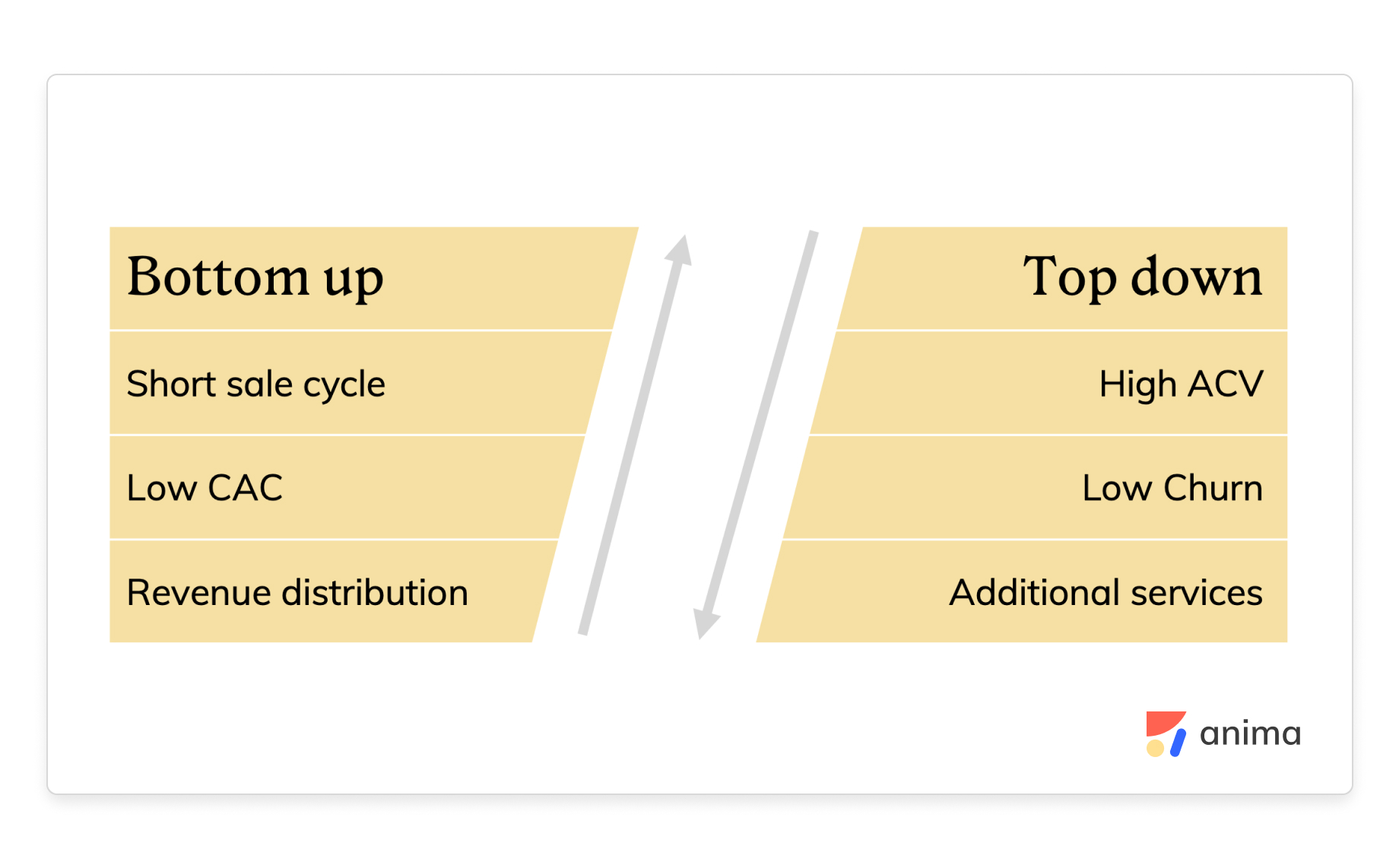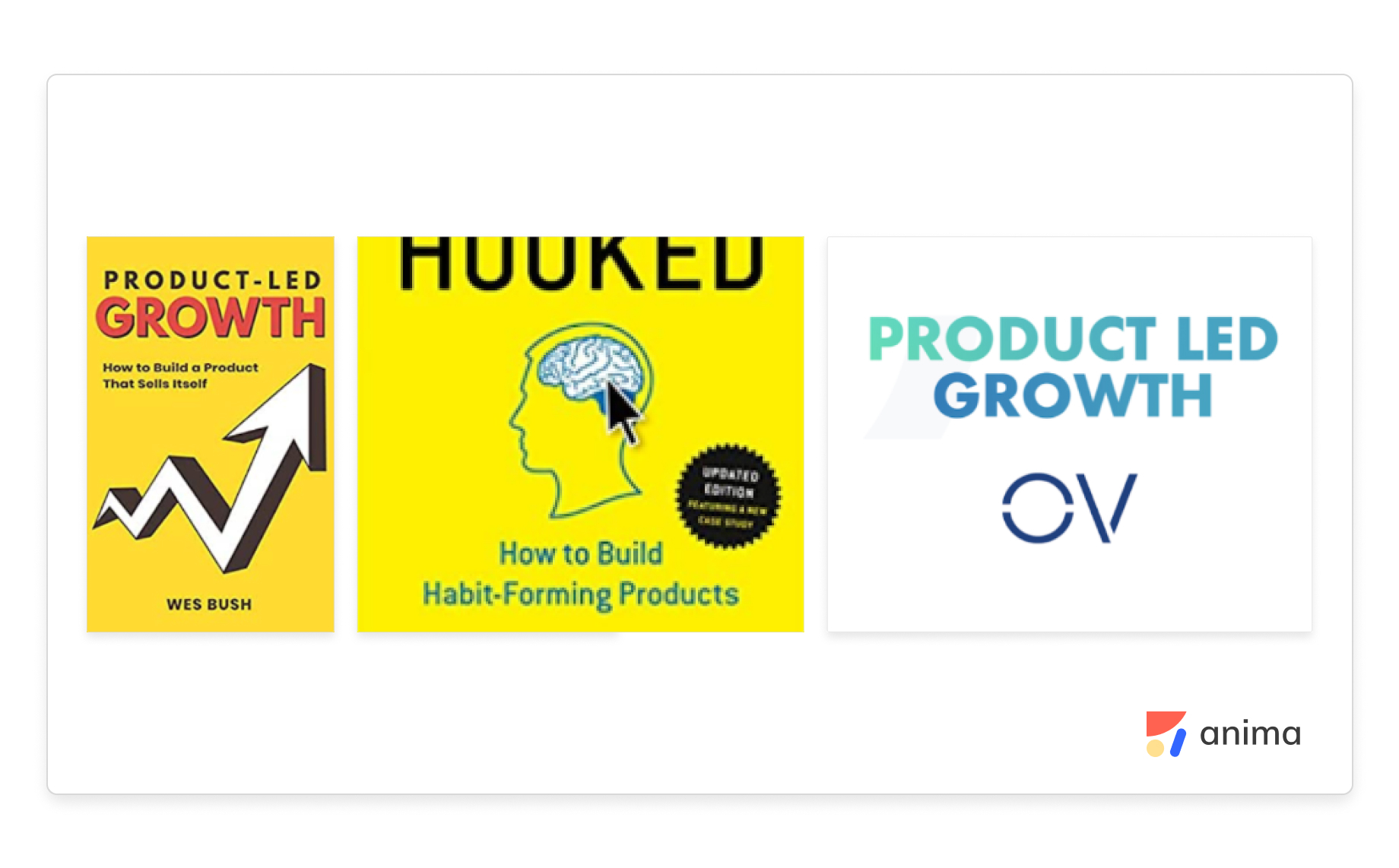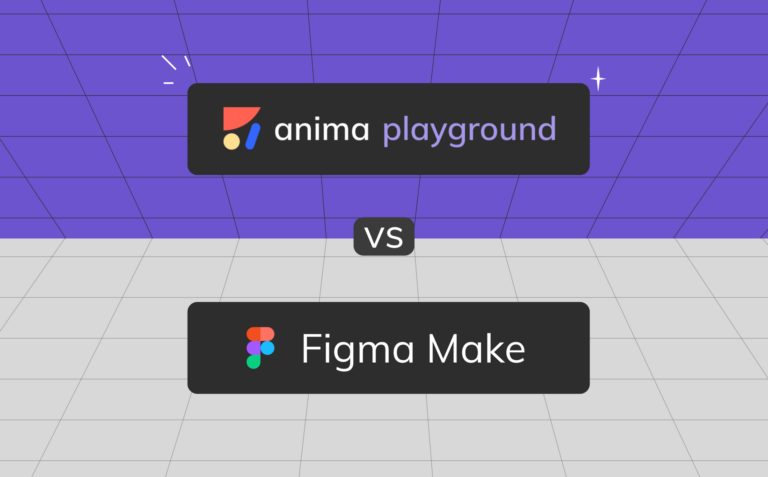What is Product led growth?8 min read
Reading Time: 7 minutesI was recently invited to talk at @ProductTank TLV and give my two cents on product-led growth.
This is a topic that I am passionate about and the driving force behind Anima, as well as huge hyper-growth companies such as Slack, Zoom, Monday, and more. So of course I took up the opportunity, and now I am sharing the main take-home messages.
Using Anima, R&D teams turn designs into code and collaborate to deliver 10x faster. We’re focusing on developers and designers, our end users. And guess what, it works.
What is product-led growth?
Product-led growth (PLG) is an end-user-focused growth model.
The product is the main driver of distribution, conversion, and expansion.
Top-down vs bottom-up approach
When selling a product to a company, you can work in two ways:
-
Top-down – This means approaching the big boss to close a big deal before the company adopts the product. Deal size is tens of thousands to millions of dollars. It involves a lot of meetings, and the product meets its users after the sale.
- It is the classic way of selling software, and it has upsides:
- Large contracts
- Low churn rate regardless of the product usage
- Selling additional services (that wouldn’t otherwise be purchased if it wasn’t for talking to a salesperson)
-
Bottom-up (PLG works bottom-up) – This means that end-users meet the product first. The people who use the product get to try it out, get value, decide to pay for it and bring their friends. Later, you can approach their manager, and have a bigger contract for a product their team has already adopted.
The up-side of bottom-up:- Short sale cycles – this could come down to minutes, with no humans involved
- Low CAC (cost of acquisition) – no humans involved, means zero-to-low touch
-
Revenue distribution – many contracts of different sizes. So if one customer leaves, it’s less painful

The benefits of top-down and PLG
PLG companies
There are many examples of hyper-growth PLG companies. You know about these companies from friends, blogs, forums, or a quick Google search when you look to solve your problem, and they are the answer.

Leading PLG companies
PLG is super powerful for B2B products
PLG in B2C
PLG works great for B2C. Netflix is such a company. They have one of the highest retention rates out there. Retention rate flattens around 60% across 36 months, and this means Netflix knows that a $1 is new subscribers today will with $0.60 in 3 years. Amazing.
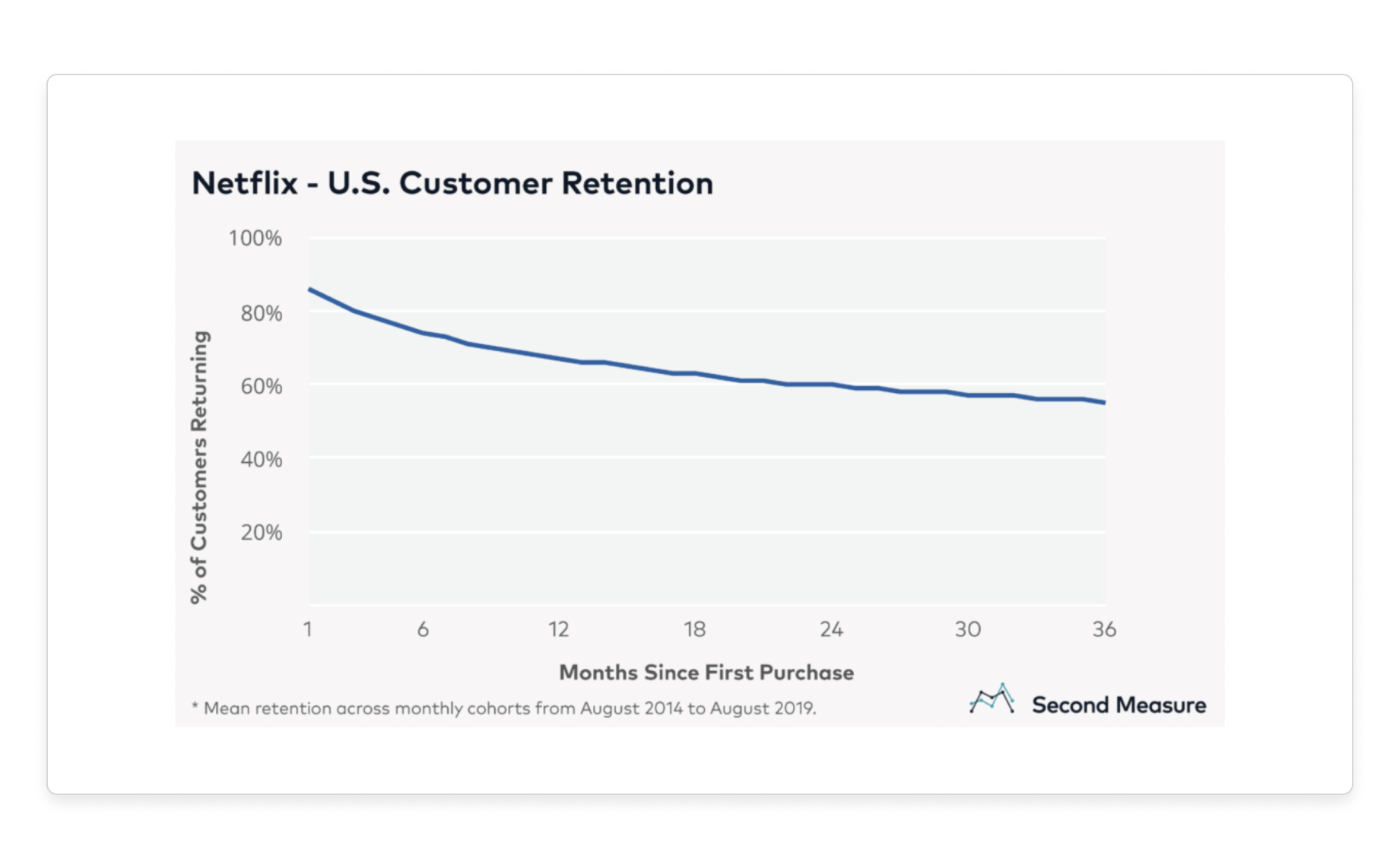
Netflix’s customer retention (source)
PLG in B2B
PLG done right in the B2B realm has a phenomenal effect. Combine collaboration makes products stick, with the fact that contracts can expand over time. And boom, you get positive NDR (Net dollar retention).
Slack is an outstanding PLG B2B company. The expansion of contracts over time results in negative churn. Yes, you read it right. At Slack, $1 of subscription today, is worth $1.40 the following year. In other words, their NDR is 140%. How could this be? Contract expansion compensates for the churn of that cohort, resulting in this beautiful chart from their S-1 application.

Slack’s customer retention (source)
Funnel, Funnel, Funnel
Users need to go from not knowing you, to loving you, paying you, and spreading the word about you, without you talking to a single person. This means your funnel looks like this:
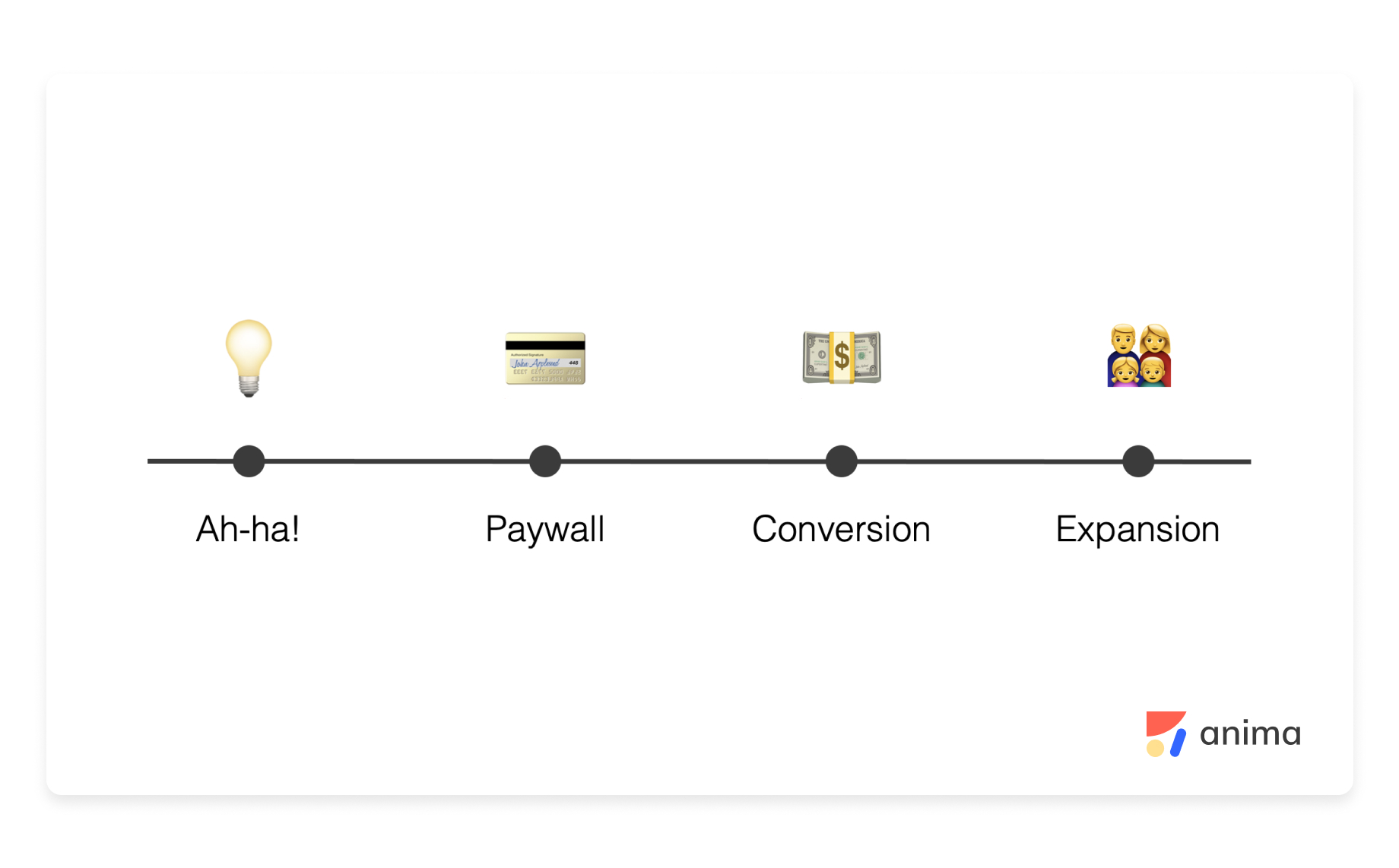
The funnel of PLG products
After discovering you through content, ads, or viral loops, users get to your product and you need to guide them through the funnel. It’s easier if you know their intent, and if you don’t – Simply ask them.
- Ah-ha moment – The user doesn’t care about your 100 features. She came here to solve a problem, show her that you can solve it asap. Short time-to-value is crucial.
- Paywalls – After showing the value you may ask to get paid in order to use the full product.
- Conversion – If you made a good case showing value and solving their problem, users will convert sooner or later.
- Expansions – Motivate users to bring friends to the product, make it part of the product flow.
Time to Value
The user got to your product with intent. We want to get them to the value ASAP – so get rid of any blockers, hide distractions, and remove all the clutter. Take them to the goal with a clear call-to-action (CTA), walkthroughs, tooltips, email automation, and any automated communication you’ve got. Here are some examples of short time-to-value:
Example #1: Wix allows any small business to create its presence online. When you sign up, you’re asked three simple questions:
- Who do you want to create a website for?
- What is the purpose of the website?
- What skill level are you?
In a matter of minutes, you get 3 websites that were made for your business. That’s a fast time to value.

Time to value: Wix - Answer 3 questions and get value instantly
Example #2: Monday is another great example of time to value. Using the same concept as Wix, they ask three simple questions and pick a template for you:
- How many people work in your organization?
- What is your industry?
- What do you want to manage?
Before you realize it, there it is, your value. Next, they bring in teammates, and bam, here’s your next sprint plan, ready to use.
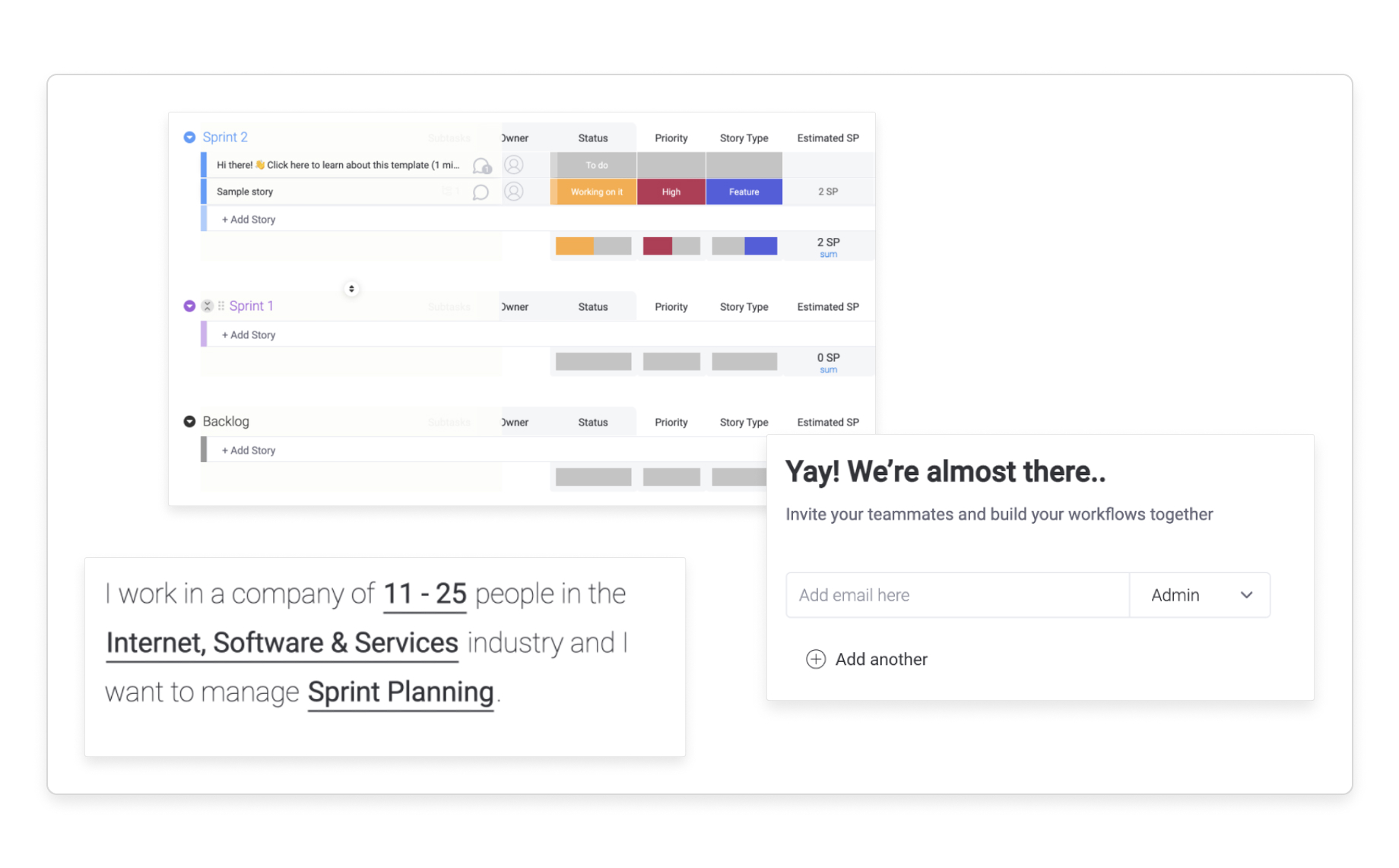
Time to value: Monday. Answer 3 questions, bring your team, get instant value
Example #3 Anima. Here at Anima, we convert design into code. In order to have the shortest time to value, we allow designers to click a button in their design tool, and within seconds they see HTML code running in the browser with their creations.
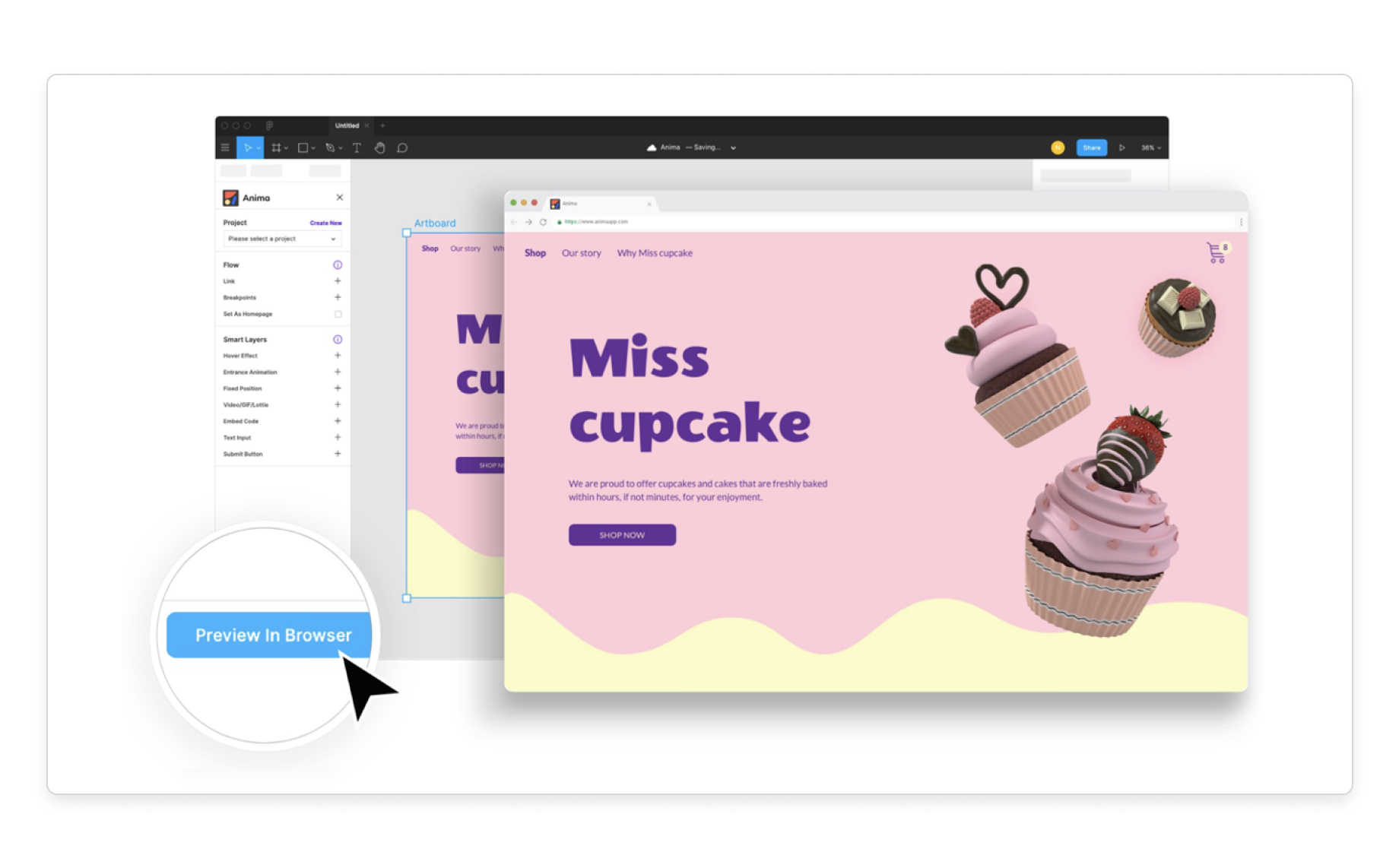
Time to value: Click a button in your design tool, and boom, here’s running code
Viral loops
In PLG, your product is in charge of expansion and distribution. Enter viral loops.
Encourage them to bring in their friends and co-workers. If possible, make it part of the product’s critical path, otherwise find motivation for them to incite friends. Here ar some examples of viral loops done right.
Example #1: Calendy a scheduling platform that helps users book appointments and meetings easily across time zones. Users send a calendy to the person they are meeting and then that person has just experienced the comfort (value) of the product.
Example #2: Anima, allows users to invite collaborators and stakeholders into Anima to see their creations. Once you’re in, you’re exposed to the value, the power of automated design-to-code.
Example #3: Audible is Amazon’s audio-book store. Reading isn’t collaborative, but they did find a great viral loop. Instead of just recommending your friends books, how about giving the book to a friend for free? And now, that friend can see the value of Audible.
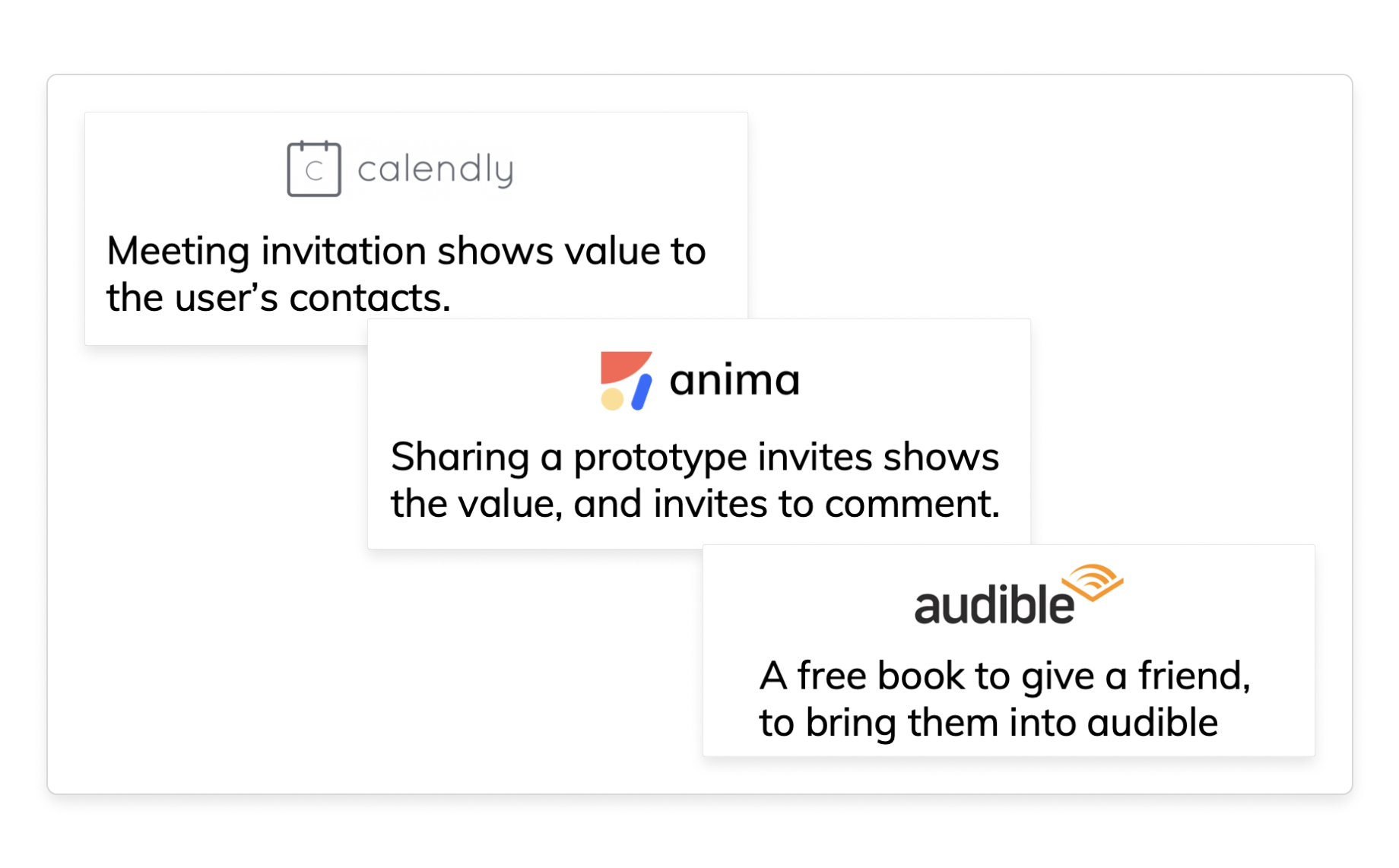
Users bring more user to discover the value of your product
Creating habits
When your users have the problem you’re solving, they need to be the first thing that comes to mind. Don’t let them forget about you, but do it in a way that again, gives value, don’t spam.
Push notifications, emails, slack integrations, and even text messages, are a great way to stay in touch with your user. If you’re a mobile or a desktop app, it always helps to be on the desktop or in the top bar.
Example #1: Loom allows you to record and share screencasts. One way they remind you that they exist is by letting you know when someone watched your video. You get a dopamine rush and a reminder that you’re getting value out of Loom.
Example #2: Audible subscription gives you one free audiobook a month. Sending you a reminder (instead of the monthly bill) reminds you that you can get a free book today. Helpful, not spammy.
Example #3: Asana is a task management platform. With its Slack integration, you’re getting relevant notifications that lets you stay up to date, you remember that Asana is there, and you’re even encouraged to engage with it right from Slack. Super slick.
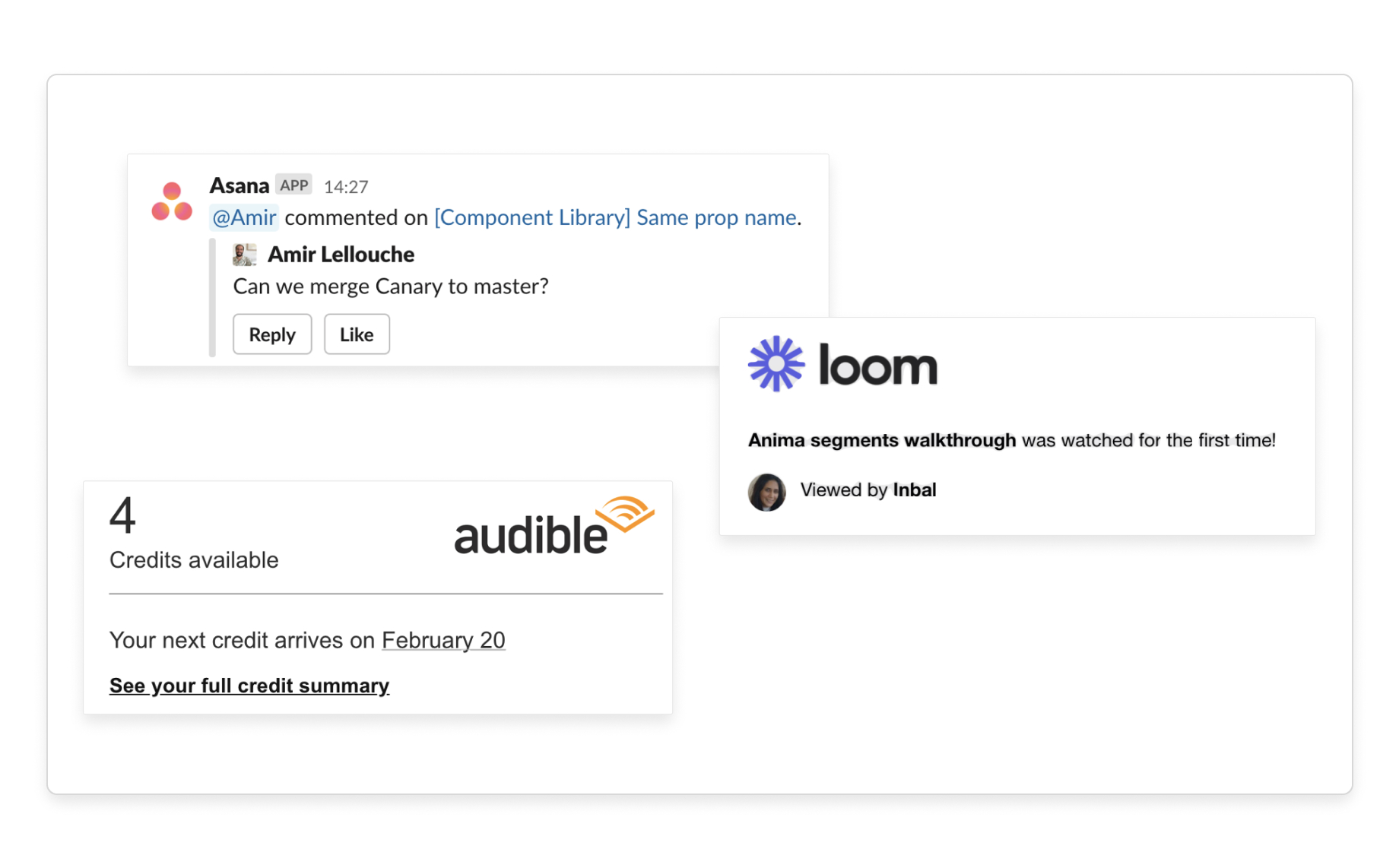
Creating habits: Audible, Asana and Loom
Summary
PLG is an end user-focused growth model that has proven itself well, and I believe that in the future it’ll be the standard way to sell to organizations. Giving users value before asking them to pay, and allowing companies to adopt a product before committing to it makes sense. We saw how powerful it is when it comes to PLG B2B, with the product expanding itself and leading to high net-dollar-retention (NDR), resulting in hyper-growth.
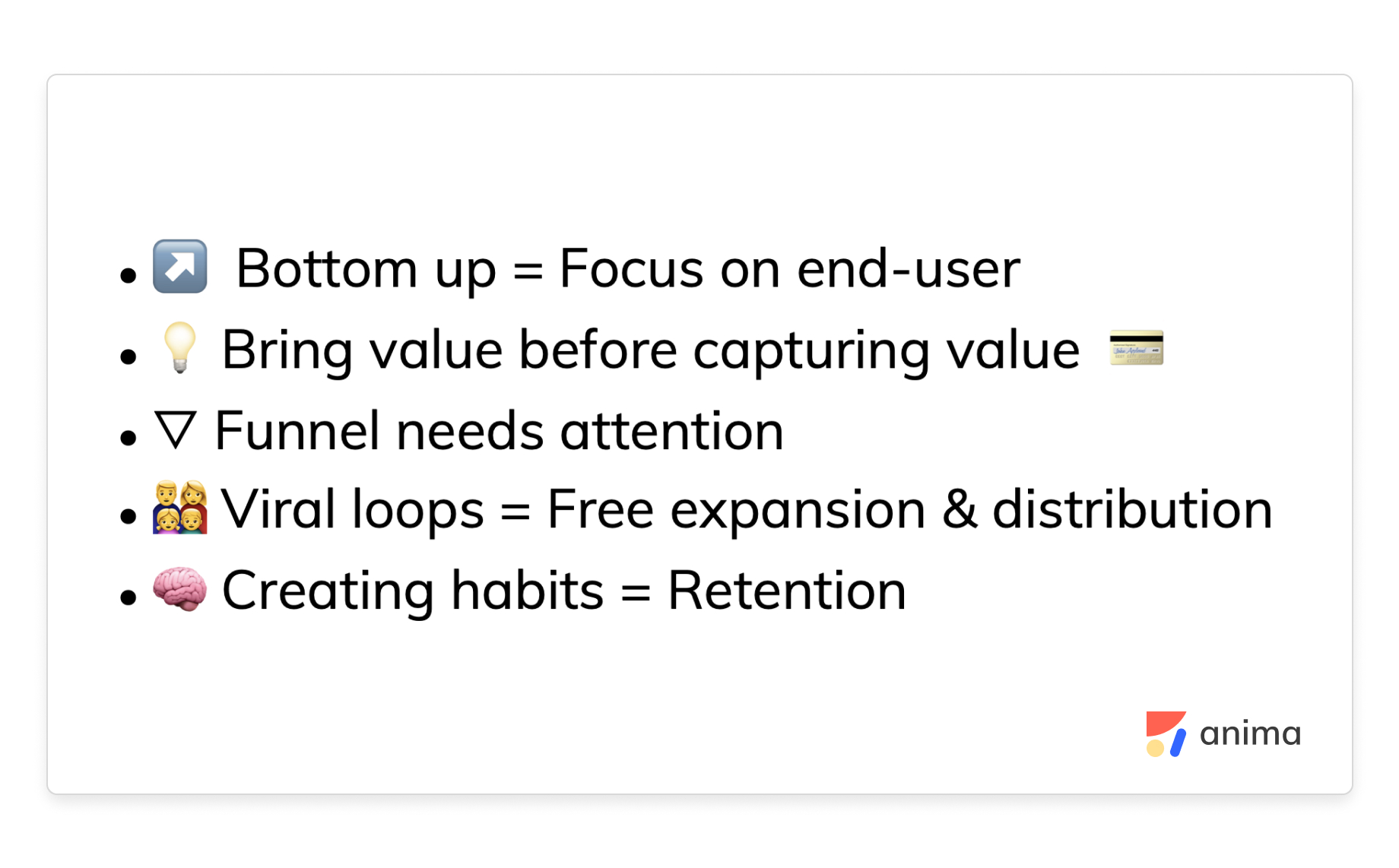
Main take-home points for PLG
Additional reads
If you’d like to learn more, I recommend these:
Recommended reads for PLG
Anima helps deliver faster
UX (user experience) expectations have gone up substantially over the past few years. UI code frameworks such as React or Vue.js make really improve the work-life of a developer. Design tools are also evolving, with tools like Figma, Adobe XD, and Sketch.
But alongside this change, we are still seeing designers and developers communicate through images. It’s time to provide value to this audience and automate the design to code process, saving on the heavier, time-consuming grunt work.
We created Anima to help teams to run faster, find out more about Anima here.


 Figma
Figma Adobe XD
Adobe XD Sketch
Sketch Blog
Blog
